The 2020 Mac Mini Unleashed: Putting Apple Silicon M1 To The Test
by Andrei Frumusanu on November 17, 2020 9:00 AM ESTBenchmarks: Whatever Is Available
As we’ve had very little time with the Mac mini, and the fact that this not only is a macOS system, but a new Arm64-based macOS system, our usual benchmark choices that we tend to use aren’t really available to us. We’ve made due with a assortment of available tests at the time of the launch to give us a rough idea of the performance:

One particular benchmark that sees the first light of day on macOS as well as Apple Silicon is Cinebench. In this first-time view of the popular Cinema4D based benchmark, we see the Apple M1 toe-to-toe with the best-performing x86 CPUs on the market, vastly outperforming past Apple iterations of Intel silicon. The M1 here loses out to Zen3 and Tiger Lake CPUs, which still seem to have an advantage, although we’re not sure of the microarchitectural characteristics of the new benchmark.
What’s notable is the performance of the Rosetta2 run of the benchmark when in x86 mode, which is not only able to keep up with past Mac iterations but still also beat them.
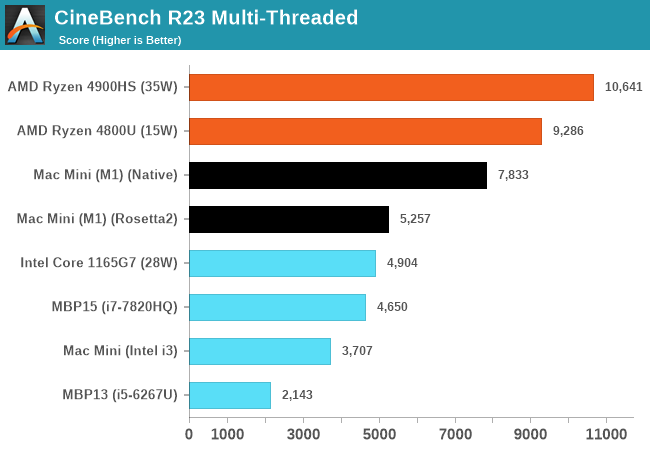
In the multi-threaded R23 runs, the M1 absolutely dominates past Macs with similar low-power CPUs. Just as of note, we’re trying to gather more data on other systems as we have access to them, and expand the graph in further updates of the article past publishing.
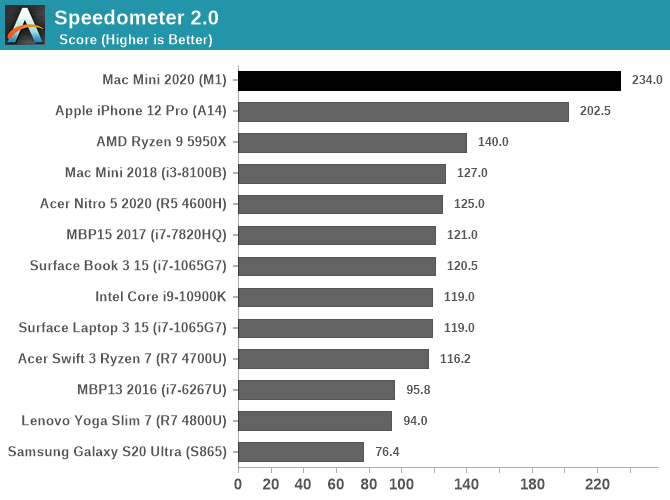
In browser-benchmarks we’ve known Apple’s CPUs to very much dominate across the landscape, but there were doubts as to whether this was due to the CPUs themselves in the iPhone or rather just the browsers and browser engines. Now running on macOS and desktop Safari, being able to compare data to other Intel Mac systems, we can come to the conclusion that the performance advantage is due to Apple’s CPU designs.
Web-browsing performance seems to be an extremely high priority for Apple’s CPU, and this makes sense as it’s the killer workload for mobile SoCs and the workload that one uses the most in everyday life.
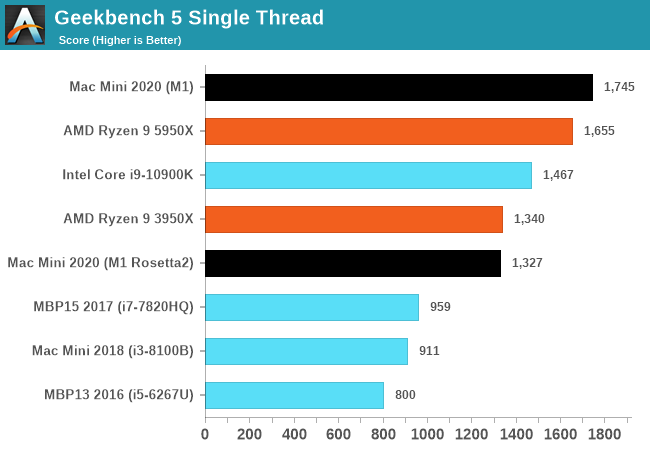
In Geekbench 5, the M1 does again extremely well as it actually takes the lead in our performance figures. Even when running in x86 compatibility mode, the M1 is able to match the top single-threaded performance of last generation’s high-end CPUs, and vastly exceed that of past iterations of the Mac mini and past Macbooks.
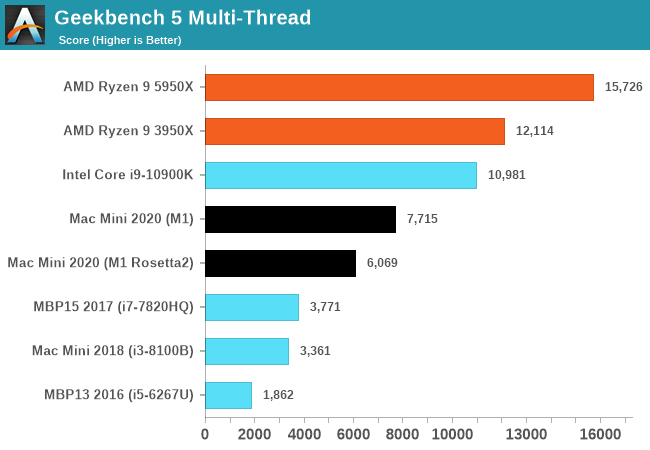
Multi-threaded performance is a matter of core-count and power efficiency of a design. The M1 here demolishes a 2017 15-inch Macbook Pro with an Intel i7-7820HQ with 4 cores and 8 threads, posting over double the score. We’ll be adding more data-points as we collect them.


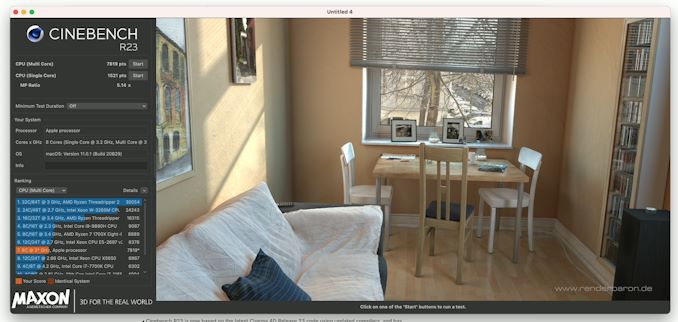








682 Comments
View All Comments
andrewaggb - Tuesday, November 17, 2020 - link
Pretty much. There's no reason to think the cores will be better on a chip with more of them. The only thing that is a possibility (certainly not a given) is that the clock speed will be substantially higher which should put Apple in the lead. That said, the previous review showed a very modest IPC improvement this time around even with huge reorder buffers and an 8-wide design. So I suspect apple's best course for improved performance is higher clocks but that always runs counter to power usage so we'll see. AMD and Intel will probably have to go wider to compete with Apple for single thread IPC in the long run.GPU-wise it's pretty decent for integrated graphics but if you want to play games you shouldn't be running Mac OS or using integrated graphics. It'll be interesting to see if Apple's market share jumps enough to pull in some game development.
Eric S - Tuesday, November 17, 2020 - link
I’m don’t think any of these benchmarks are optimized for TBDR. Memory bound operations could be significantly faster if optimized for the chip. Many render pipelines could run 4X faster. I’m curious to see iOS graphics benchmarks run on this that are more representative. Of course I hope we see apps and games optimized for TBDR as well.Spunjji - Thursday, November 19, 2020 - link
@andrewaggb - Agreed entirely. The cores themselves aren't going to magically improve, and it's not clear from the meagre scaling between A14 at 5-10W and M1 at 10-25W that they can make them a lot faster with clock speed increases. But a chip with 12 Firestorm cores and 4 Icestorm cores would be an interesting match for the 5900X, and if they beef the GPU up to 12 cores with a 192bit memory interface and/or LPDDR5 then they could have something that's actually pretty solid for the vast majority of workloads.I don't think games are going to be moving en-masse from Windows any time soon, but I guess we'll see as time goes on.
Stephen_L - Tuesday, November 17, 2020 - link
I feel very lucky that I didn’t use your mindset when I decided to buy AMD R5-1600X instead of an Intel i5 for my pc.Spunjji - Thursday, November 19, 2020 - link
@YesYesNo - you responded to a comment about how they *will* be releasing faster chips by talking about how they haven't done so yet. This is known. You're kind of talking past the people you're replying to - nobody's asking you to reconsider how you feel about the M1 based on whatever comes next, but it doesn't make sense to assume this is the absolute best they can do, either.andreltrn - Tuesday, November 17, 2020 - link
This is not their High-end chip! This a chip for low-end devices such as fan-less laptops. They attacked that market first because this where they will make the most money. High end Pro won't go for a new platform until it is proven and that they are 100% sure that they will be able to port their workflow to it. They are starting with the low-end and follow up with probably a 10 or 12 core chip in the spring for the high-end laptop and the iMac.vlad42 - Tuesday, November 17, 2020 - link
I just do not see Apple using any but a low power mobile chip for consumer devices.Think about it, about half the time we did not see Apple release a tablet optimized A#X chip for the iPad. In their recent earnings reports the combined iPad and Mac revenue is still only half that of the iPhone. By using the same chip for the iPad and all Mac machines, except the Mac Pro, maybe Apple will actually update the soc every year.
If apple were to provide a higher performing chip for consumer devices, then it would probably be updated only once every few years. Apple just does not make enough money from high end laptops and the iMac to justify dedicated silicon for those products without pulling an Intel and reusing the soc for far too many product cycles. Just look at the Mac Pros. The engineering resources needed to design the most recent x86 Mac Pro is a drop in the bucket compared to designing and taping out a new soc. Despite this, Apple has only been updating the Mac Pro lineup once every 5-7 years!
The problem, is that by the time they are willing to update those theoretical high end consumer chips, they will have been long since been made obsolete. Who in their right mind would purchase a "high end" laptop or an iMac if it is out performed by an entry level Air or an iPad or was lacking in important features (hardware codec support, the next stupid version of HDCP needed for movies/TV shows, etc.). Even worse for Apple is if their customers by a non-Apple product instead. Much of Apple's current customer base does not actually need a Mac. They would be fine with any decent quality high end laptop or any all-in-one with a screen that is not hot garbage.
Eric S - Tuesday, November 17, 2020 - link
They are working on updates for the high end. I expect they will be amazing. At least two higher end chips are in late design or early production.Eric S - Tuesday, November 17, 2020 - link
You are probably right in that they may only be updated every few years, but the same can be said of the Xeon which also skips generations.vlad42 - Tuesday, November 17, 2020 - link
But the Xeon chips are a bad example because Intel shot themselves in the foot through a combination of complacency, tying their next gen products too tightly to the manufacturing process and a shortage of 14nm capacity. We used to get new Xeons if not every year, then at least every time there was an architecture update.A better more recent comparison would be with AMD which has always updated the Threadripper lineup. Granted, we technically do not know if the Threadripper Pro lineup will be updated every year, but it very likely will be.